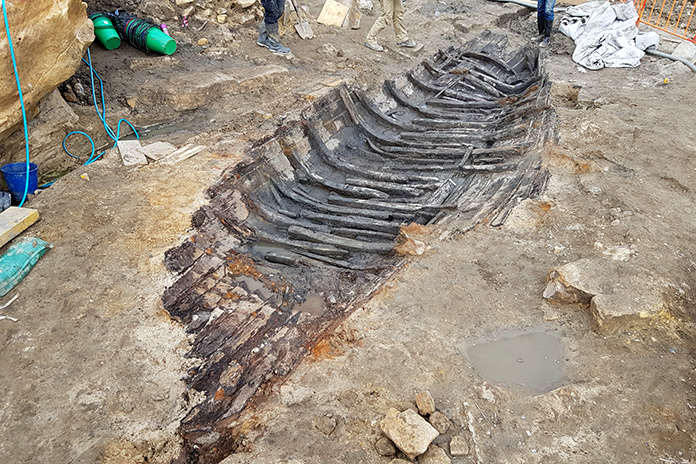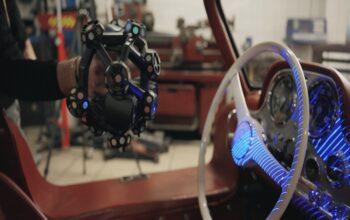If you hear about something unexpected surfacing in Australia, no one would blame you for first thinking about some kind of wily mammal making its way into town, or an alarmingly large spider that you’d be better off leaving alone.
In this case, the surprise came in the form of a boat.

“It was a development project that Sydney Metro was undertaking at several locations in Sydney city”, said Irini Malliaros (known to her friends and colleagues as Renee), project manager and maritime archaeologist at Silentworld Foundation, an Australian non-profit focused on maritime archaeology, history, culture, and heritage. In this particular area of reclaimed land, at the site of the future Barangaroo Metro station, the team encountered what was once a shipyard. The area is named after Barangaroo, an Aboriginal woman of the Cammeraygal clan who was a powerful leader at the time of European colonization. “So, of course, they came across all sorts of maritime-related objects,” said Malliaros, “including a little boat.”

Once the boat, thought to date to around 1820, was discovered, there were lengthy discussions about how to excavate it – in one piece or bit by bit.
“Eventually, it was deemed safer for the object to be taken apart and to have each piece removed, recorded on-site, wrapped up, stored, and transported in refrigerated shipping containers,” Malliaros explained. “[So now] we’ve basically got this 12-meter-long by 3-to 3.5-meter-wide boat, in pieces, in water tanks, being conserved at the Sydney Metro conservation and storage facility.”
The task for the team has since then been to find a way to digitally record this boat, find out everything they can from it, and then digitally recreate it while the original boat is prepared for display. And the scanner tasked with the job: Artec Eva.
“I have spoken with Renee many, many times over the last few years, and have been up to visit them once the initial shipwreck was delivered,” said Ben Myers, Director of 3D scanning at Artec 3D Gold Certified Partner Thinglab.
“This is a particularly interesting and exciting project; not only for the fact the ship is the oldest colonial Australian-built craft ever to be excavated but also for the way that this has been managed. Using Eva to record each piece to then digitally rebuild this, is fascinating.”
Scanning each plank
For a task this detailed and complex, the assistance of someone who specializes in tasks of this sort was required. In this case, Thomas Van Damme, a 3D recording specialist and maritime archaeologist in Belgium who was part of the team that developed the process of recording ship’s timbers in this way, was flown down to Australia to train the team.

With the expertise of Van Damme and the use of Eva, scanning went ahead quickly, especially compared to previous methods such as 3D contact tracing – a process which would take hours to trace every edge, or 2D drawings, which were cheap but time-consuming and inaccurate.
“With (typical) 3D contact digitization, you’re only tracing the features that the archaeologist thinks are important, but you’re missing some features”, said Van Damme. “What Artec Eva gives you is an objective 3D reproduction of the timber itself having both geometry and color.”
Artec Eva is the flagship scanner of Artec, and for good reason – the lightweight, portable 3D scanner is incredibly versatile and an ideal choice for making accurate, textured 3D scans. Used for small to medium-sized objects in industries ranging from science and education to art and design, structured-light scanning with Eva is excellent for anything from a human bust to – in this case – a 200-year-old boat.

For digitally capturing the boat, the efficiency that Eva provided was essential.
“Scanning with Artec Eva, some of the pieces were so little I’d just zip around it once, flip it over, zip around it again, and that was it,” said Malliaros. “I was actually getting dizzy because I was walking so fast!”
Because each piece – and there were nearly 300 of them – had been wrapped and stored in such a way that their original form, or the form in which they were found, was preserved, they needed to be recorded as soon as they were unwrapped.
“After that, they go into the water and they start to relax. They may change shape. So, we had to do it quickly, and we had to do it accurately,” Malliaros said.

For larger pieces which function as essential structural parts of the ship, such as the keel, scanning took up to 15 minutes, with some of the more thin pieces, such as planks, suspended to ensure scanning could be done in one go.
“The capture was so good and so quick!” recalled Malliaros. “I set it to real-time fusion, so it was like painting it as I was going.”
Processing the Parts
After processing the scan data in Artec Studio software, the team imported the 3D models into modeling software Rhino, where they highlighted major features.
“It’s really important that we highlight the patterns – tool marks, nail-hole patterns, grain direction, compression marks, etc. – because that’s all going to be really crucial data for later on,” Malliaros said, adding that more scientific analyses of the fabric of the boat and the surrounding sediment are also in the works.


“[3D scanning and processing] with Eva is a relatively easy process, and it’s also quite satisfying and ergonomic,” Van Damme said. “You immediately have digital solids, so you don’t have to trace the edges – using Rhino you’re able to quickly create 2D drawings of every piece [for documentation].”
With this process, everything was far more quickly and efficiently, compared to recording methods used previously, which would have taken much longer.
The Boat’s Big Day
While the sections of the boat remain safely in treatment, undergoing a process where water in the wood is replaced with liquid wax – a method used with such famous ships as England’s Mary Rose and Sweden’s Vasa – more work is being done to get ready for the boat’s triumphant return, with hopes for a new home in the Australian National Maritime Museum who have been supporting the project since its inception.
“On the advice of supervising conservator Ian Panter from York Archaeological Trust, the Barangaroo Boat is now in chemicals, pickling away nicely, and it will stay there for another few months, probably until next year,” said Malliaros. “And then it’ll be checked on again, to see how it’s going.” After this stage, the timbers will go into a freeze dryer in batches. Once all pieces are dry, more cleaning and care will need to be applied, and it is estimated the reconstruction will happen within the next 2-3 years.
“Before work starts on the actual pieces of the boat, there will be a practice run just to see how all the pieces are going to fit together, and also what kind of support cradle system will be needed,” Malliaros said.
For this to happen, scale versions of every single piece need to be 3D printed from the 3D models before reassembly of the timbers begins in the gallery space. “There will be a little scaled-down jigsaw puzzle version of the boat, and once that is put together – Cool! Now, to do it for real.”

Seafaring Sojourns
Since the Barangaroo Boat, Malliaros has also undertaken the scanning of three more shipwrecks (or parts thereof), bringing the total number of boats discovered and scanned to four. Moving forward, more Artec solutions may be introduced into the mix.
“We look forward to building on our relationship to assist the Foundation with exploring how they can possibly utilize more of the Artec range,” said Myers. “We are hugely honored to have helped out in a small way to assist the Silentworld Foundation in recording and using the 3D data.”
And as the massive feat of preparing this vintage boat for modern appreciation takes place, it’s the history behind it that has already begun to spark ideas of what life was like back then.
For example, while it wasn’t a commercial vessel, the boat was sturdily built, and probably was busy with small ferrying jobs up and down the rivers, down the harbor, maybe even short trips up and along the coast.
“It gives us a little bit of a clue about the socio-economic climate at the time,” said Malliaros.
“[The boat likely belonged to] someone who knew what they were doing. And the way it was built, it looks like it was somebody’s livelihood. It looks like it had a long life, so it was obviously very important to somebody.”
One can’t help but imagine what the boat owner would say if they could, centuries later, see all the plans in store for their strong and humble boat, soon to find a home where it shall stand on proud display.









